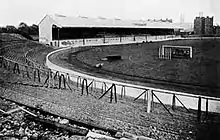1920 FA Cup Final
The 1920 FA Cup Final, the first since the end of the First World War, was contested by Aston Villa and Huddersfield at Stamford Bridge. Aston Villa won 1–0, with the goal coming in extra time from Billy Kirton, to clinch the trophy for a record sixth time.[1] This was the first ever F.A. Cup Final to require extra time to be played.[2][3]
 Stanford Bridge hosted the match | |||||||
| Event | 1919–20 FA Cup | ||||||
|---|---|---|---|---|---|---|---|
| |||||||
| After extra time | |||||||
| Date | 24 April 1920 | ||||||
| Venue | Stamford Bridge, London | ||||||
| Referee | J.T. Howcroft (Bolton) | ||||||
| Attendance | 50,018 | ||||||
This was Aston Villa's sixth F.A. Cup Final win. Their opponents had secured promotion from the Second Division this season, having nearly gone out of business, and were appearing in their first final. Aston Villa captain, Andy Ducat, had represented England at both football and cricket.[4] The Villa team had four surviving members of the club's last F.A. Cup final victory in 1913; Tommy Weston, Sam Hardy, Clem Stephenson and Charlie Wallace.[5] Those four Villa players and Frank Moss had all served in the Armed Forces during World War I.[6] Frank Barson, known for his tough style of play, was warned before the kick-off by the referee against using his normal tactics.[7]
This was Villa manager George Ramsay's sixth F.A. Cup Final win, a record for a manager, and one that was only equaled in 2016 by Arsène Wenger – against Aston Villa.[6] The trophy was presented by Prince Henry, the fourth son of King George V.[8][9]
Road to the Final
How the finalists reached the final.[10] Huddersfield Town were in the Second Division at this time.[10]
Aston Villa
| Round 1 | Aston Villa | 2–1 | Queens Park Rangers | QPR were a non-league club at this time.[10] |
| Round 2 | Manchester United | 1–2 | Aston Villa | |
| Round 3 | Aston Villa | 1–0 | Sunderland | |
| Quarter-final | Tottenham Hotspur | 0–1 | Aston Villa | Tottenham Hotspur were in the Second Division at this time[10] |
| Semi-final | Aston Villa | 3–1 | Chelsea | played at Bramall Lane, Sheffield |
Huddersfield Town
| Round 1 | Huddersfield Town | 2–1 | Brentford | Brentford were a non-league club at this time.[10] |
| Round 2 | Newcastle United | 0–1 | Huddersfield Town | |
| Round 3 | Huddersfield Town | 3–1 | Plymouth Argyle | Plymouth Argyle were a non-league club at this time.[10] |
| Quarter-final | Huddersfield Town | 2–1 | Liverpool | |
| Semi-final | Huddersfield Town | 2–1 | Bristol City | played at Stamford Bridge, London |
Match details
| Aston Villa | 1–0 (a.e.t.) | Huddersfield Town |
|---|---|---|
| Kirton |
Report |
Aston Villa
|
Huddersfield Town
|
|
| ||||||||||||||||||||||||||||||||||||||||||||||||||||||||||||||||||||||||||||||||||||||||||||
References
- "Aston Villa | Club | History | Timeline". Avfc.co.uk. Retrieved 7 August 2011.
- Tom Davis & Mat Kendrick (18 April 2015). "Aston Villa at Wembley: The 50 most memorable claret and blue moments in the FA Cup". Birmingham Mail. Retrieved 27 December 2016.
- John Motson (2005). Motson's FA Cup Odyssey: The World's Greatest Knockout Competition. Robson. p. 48. ISBN 1-861-05903-5.
- Richard William Cox; Dave Russell; Wray Vamplew, eds. (2002). Encyclopedia of British Football. Psychology Press. p. 16. ISBN 0-714-65249-0.
- "Aston Villa's FA Cup Finals". Retrieved 27 December 2016.
- "Villa's WWI heroes". Retrieved 27 December 2016.
- Simon Brunton (16 December 2014). "The forgotten story of … Frank Barson's seven-month ban". The Guardian. Retrieved 27 December 2016.
- "Aston Villa v Huddersfield FA Cup Final 1920". Archived from the original on 28 December 2016. Retrieved 27 December 2016.
- Rory Benson (15 August 2016). "Aston Villa vs Huddersfield Town: Pick your Terriers team to start at Villa Park". The Huddersfield Daily Examiner. Retrieved 27 December 2016.
- "1920 FA Cup Results". Retrieved 27 December 2016.